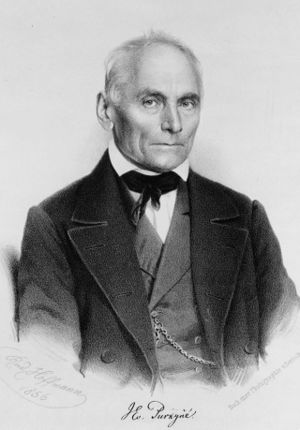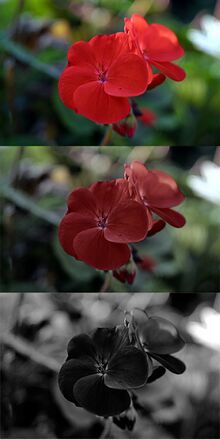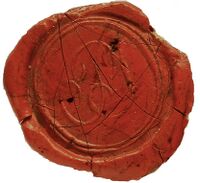يان إفانجليستا بوركنيى
Jan Evangelista Purkyně | |
|---|---|
 Purkyně in 1856 | |
| وُلِدَ | 18 ديسمبر 1787 |
| توفي | 28 يوليو 1869 (aged 81) |
| الجنسية | تشيكي |
| المدرسة الأم | جامعة پراگ |
| اللقب | Purkinje cells Purkinje effect Purkinje images Purkinje fibres |
| السيرة العلمية | |
| المجالات | علم التشريح، فسيولوجيا |
| الهيئات | جامعة برسلاو |
يان إفانجليستا بوركنيى أو Jan Evangelista Purkyně (تشيكية: [ˈjan ˈɛvaŋɡɛlɪsta ˈpurkɪɲɛ] (![]() استمع)؛ كما يُكتب Johann Evangelist Purkinje) (17 أو 18 ديسمبر 1787 – 28 يوليو 1869) was a Czech anatomist and physiologist. In 1839, he coined the term protoplasm for the fluid substance of a cell. He was one of the best known scientists of his time. Such was his fame that when people from outside Europe wrote letters to him, all that they needed to put as the address was "Purkyně, Europe".[1]
استمع)؛ كما يُكتب Johann Evangelist Purkinje) (17 أو 18 ديسمبر 1787 – 28 يوليو 1869) was a Czech anatomist and physiologist. In 1839, he coined the term protoplasm for the fluid substance of a cell. He was one of the best known scientists of his time. Such was his fame that when people from outside Europe wrote letters to him, all that they needed to put as the address was "Purkyně, Europe".[1]
. . . . . . . . . . . . . . . . . . . . . . . . . . . . . . . . . . . . . . . . . . . . . . . . . . . . . . . . . . . . . . . . . . . . . . . . . . . . . . . . . . . . . . . . . . . . . . . . . . . . . . . . . . . . . . . . . . . . . . . . . . . . . . . . . . . . . . . . . . . . . . . . . . . . . . . . . . . . . . . . . . . . . . . .
السيرة
وُلِد پوركنيى في مملكة بوهيميا (التي كانت آنذاك جزءاً من الملكية النمساوية، والآن جمهورية التشيك). After completing senior high school in 1804, Purkyně joined the Piarists order as a monk but subsequently left "to deal more freely with science."[2]In 1818, he graduated from Charles University in Prague with a degree in medicine, where he was appointed a Professor of Physiology. He discovered the Purkinje effect, the human eye's much reduced sensitivity to dim red light compared to dim blue light, and published in 1823 description of several entoptic phenomena. He published two volumes, Observations and Experiments Investigating the Physiology of Senses and New Subjective Reports about Vision, which contributed to the emergence of the science of experimental psychology. He created the world's first Department of Physiology في جامعة برسلاو في پروسيا (هي الآن ڤروتسواف، پولندا) في 1839 وثاني معمل فسيولوجيا في العالم في 1842. وهناك كان مؤسس Literary-Slav Society.
In 1850, he accepted the Physiology chair at Prague Medical Faculty, a position he held until his death. [3]
He is best known for his 1837 discovery of Purkinje cells, large neurons with many branching dendrites found in the cerebellum. He is also known for his discovery in 1839 of Purkinje fibres, the fibrous tissue that conducts electrical impulses from the atrioventricular node to all parts of the ventricles of the heart. Other discoveries include Purkinje images, reflections of objects from structures of the eye, and the Purkinje shift, the change in the brightness of red and blue colours as light intensity decreases gradually at dusk. Purkyně also introduced the scientific terms plasma (for the component of blood left when the suspended cells have been removed) and protoplasm (the substance found inside cells.)[4]
Purkyně was the first to use a microtome to make thin slices of tissue for microscopic examination and was among the first to use an improved version of the compound microscope. He described the effects of camphor, opium, belladonna and turpentine on humans in 1829. He also experimented with nutmeg that same year, when he "washed down three ground nutmegs with a glass of wine and experienced headaches, nausea, euphoria, and hallucinations that lasted several days", which remain a good description of today's average nutmeg binge.[5] Purkyně discovered sweat glands in 1833 and published a thesis that recognised 9 principal configuration groups of fingerprints in 1823.[6][7] Purkyně was also the first to describe and illustrate in 1838 the intracytoplasmic pigment neuromelanin in the substantia nigra.[8]
Purkyně also recognised the importance of the work of Eadweard Muybridge. Purkyně constructed his own version of a stroboscope which he called forolyt.[9] He put nine photos of him shot from various sides to the disc and entertained his grandchildren by showing them how he, an old and famous professor, is turning around at great speed.[10]
العائلة والوفاة
In 1827, at the age of 40, he married Julia Agnes Rudolphi (1800–1835), daughter of his supporter, a Swedish-born natural scientist, Karl Asmund Rudolphi (1771–1832). They had two daughters and two sons. His wife and daughters died of cholera in Wrocław, leaving two sons. The older son cs (Emanuel Purkyně) (1831–1882) became a naturalist, while the younger son Karel (1834–1868) became a painter.[11]
He is buried in the Prague Vyšehrad National Cemetery in Vyšehrad, Prague, in modern-day Czech Republic.[12]
الذكرى
The Masaryk University in Brno, Czech Republic, bore his name from 1960 to 1990, as did the standalone military medical academy in Hradec Králové (1994–2004.) Today, a university in Ústí nad Labem bears his name: Jan Evangelista Purkyně University in Ústí nad Labem (Univerzita Jana Evangelisty Purkyně v Ústí nad Labem.)
The crater Purkyně on the Moon is named after him, as is the asteroid 3701 Purkyně.
انظر أيضاً
المراجع
- ^ Bhattacharyya, KB. Eminent Neuroscientists: Their Lives and Works. Bimal Kuman Dhur of Academic Publishers, 2011, p.182
- ^ Cavero, Icilio; Guillon, Jean-Michel; Holzgrefe, Henry H. (1 December 2017). "Reminiscing about Jan Evangelista Purkinje: a pioneer of modern experimental physiology". Advances in Physiology Education. 41 (4): 528–538. doi:10.1152/advan.00068.2017. ISSN 1043-4046. PMID 29066603.
- ^ Cavero, Icilio; Guillon, Jean-Michel; Holzgrefe, Henry H. (1 December 2017). "Reminiscing about Jan Evangelista Purkinje: a pioneer of modern experimental physiology". Advances in Physiology Education. 41 (4): 528–538. doi:10.1152/advan.00068.2017. ISSN 1043-4046. PMID 29066603.
- ^ Ball, Philip (2016). "Man Made: A History of Synthetic Life". Distillations. 2 (1): 15–23. Retrieved 22 March 2018.
- ^ Shafer, Jack (14 December 2010) Stupid drug story of the week: The nutmeg scare, Slate.com
- ^ Jan Evangelista Purkyně, Commentatio de examine physiologico organi visus et systematis cutanei (Breslau, Prussia: University of Breslau Press, 1823)
- ^ Harold Cummins and Rebecca Wright Kennedy (1940). "Purkinje's observations (1823) on finger prints and other skin features". The Journal of Criminal Law and Criminology. 31 (3): 343–356. doi:10.2307/1137436. JSTOR 1137436.
- ^ Usunoff, KG. Itzev, DE. Ovtscharoff, WA. Marani, E. Neuromelanin in the human brain: a review and atlas of pigmented cells in the substantia nigra. Archives of Physiology and Biochemestry, 2002, No. 4, p. 257
- ^ Sight and Sound British Film Institute, 1946
- ^ Ludvík Souček, Jak se světlo naučilo kreslit (How the light learned to draw), SNDK, Prague, 1963, pp. 106–7.
- ^ Mazurak, Magdalena; Kusa, Jacek (February 2018). "Jan Evangelista Purkinje: A Passion for Discovery". Texas Heart Institute Journal. The Texas Heart Institute. 45 (1): 23–26. doi:10.14503/THIJ-17-6351. PMC 5832080. PMID 29556147.
- ^ Reminiscing about Jan Evangelista Purkinje: a pioneer of modern experimental physiology
وصلات خارجية
| يان إفانجليستا بوركنيى
]].- Jan Evangelista Purkyně at Monoskop.org
- Biography, "Purkyně (Purkinje), Jan Evangelista." @ Complete Dictionary of Scientific Biography. 2008. Encyclopedia.com biographical entry written by Vladislav Kruta
- يان إفانجليستا بوركنيى at Find a Grave
- Short description is different from Wikidata
- مواليد 1787
- وفيات 1869
- People from Libochovice
- أشخاص من مملكة بوهيميا
- كتاب اللغة اللاتينية في القرن 19
- خريجو جامعة كارلوڤا
- طاقم تدريس جامعة كارلوڤا
- مشرحون نمساويون
- فسيولوجيون نمساويون
- علماء نمساويون
- مشرحون تشيك
- Czech neuroscientists
- Czech physiologists
- علماء تشيك في القرن 19
- أعضاء أكاديمية العلوم الپروسية
- أعضاء أكاديمية العلوم الفرنسية
- الأعضاء المراسلون لأكاديمية العلوم بسانت پطرسبورگ
- أعضاء أجانب في الجمعية الملكية
- تاريخ علم الأعصاب
- طاقم تدريس جامعة برسلاو
- جامعة ماساريك
- Burials at Vyšehrad Cemetery

